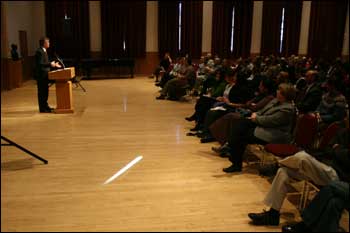
Robert Shelton believes the future may be dim for many public research institutions.
Shelton, the 19th president of the University of Arizona, says competition with affluent private institutions is moving research away from public universities.
“We have a problem here,” Shelton said. “The problem is that ‘publics’ are where we educate America. We cannot lose the power of those public research universities.”
However, Shelton also believes he has a solution for those publics: Look outside your own institutions to collaborate on important projects that capitalize on individual strengths.
Shelton was the third speaker in the 2006-07 President’s Speakers Series on “The Changing Landscapes in Higher Education,” which has featured Diana Oblinger, vice president of EDUCAUSE, and Rufus Glasper, chancellor of the Maricopa County Community College District. In April, NAU President John Haeger will discuss the lessons learned from the series.
Shelton told a nearly full Ashurst Auditorium on Thursday that today’s students and parents want options, donors expect innovative thinking and the public wants to know how supporting public universities will benefit them—now.
“A savvy university must recognize these market forces,” he said. “We need to take a page or two out of the corporate playbook. Businesses have found that alliances can satisfy and keep a customer base. Universities can find that alliances are not only cost effective but critical to our mission.”
The University of Arizona embraces joint projects around the Tucson campus, such as in engineering and astronomy or the five disciplines that constitute the Bio 5 Institute. “The results of our collaborations are tangible,” he said. “This is science history in the making.”
Yet the “joy of collaboration” comes off campus, Shelton said, pointing out the “hundreds if not thousands” of collaborative efforts between UofA and Northern Arizona University.
He specifically cited NAU’s role in the downtown Phoenix medical school, which will include NAU’s expansion of programs in the health professions. “The health professions programs will be a fundamental part of the Phoenix medical campus,” he said. “Not a single major medical college is without the related fields. We need you. Thank you for coming to Phoenix.”
He also mentioned the Native American Cancer Research Project, which pairs NAU and UofA to focus “on a key issue facing society,” cancer rates among Native American populations. “I know we couldn’t pull this off only in Tucson,” Shelton said. “But together, we are making progress on this major challenge.”
The Arizona Water Institute, an effort that includes NAU, UofA, Arizona State University and state agencies, also was mentioned as “a research effort that should fill us all with pride.”
Shelton explained, “Gov. (Janet) Napolitano organized the institute and gave some money to help draw people together, and if we collaborate, we will show that we’re the best in the country at dealing with this issue.”
The three state universities cannot be content to be exclusive purveyors of their strengths, he said. “Our success is going to rest on our ability to lean on each other.”



